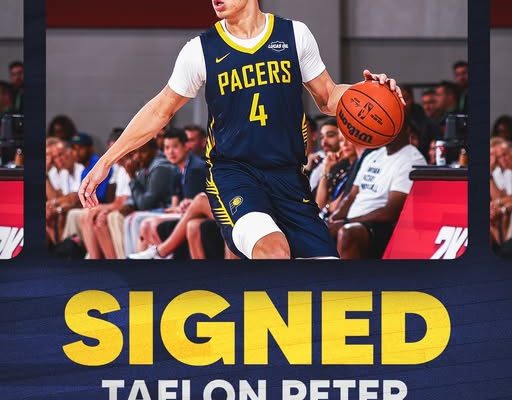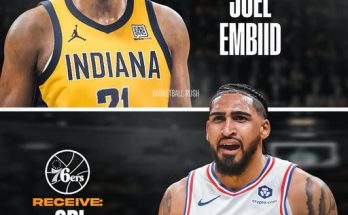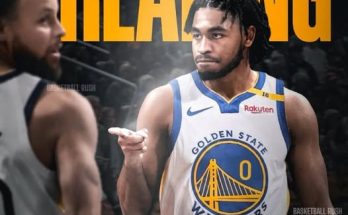When news broke that the team had signed Taelon Peter to a two-way contract, it didn’t just add a name to the roster—it injected a shot of raw energy and untapped potential into the foundation of a franchise hungry for development, grit, and production from the margins. For many casual fans, the name may not ring as loud as a lottery pick or a free agent superstar, but for those in basketball circles who’ve watched Peter grind, explode, and evolve across the past few seasons, this signing marks a calculated risk with potentially high returns. It’s not just about bolstering depth—it’s about betting on an uncut gem that could thrive with opportunity, coaching, and the right environment.
Taelon Peter, the 6-foot-4 guard who carved out a name for himself through sheer will and athleticism, has long been on the radar of scouts looking for sleeper talent. What makes him unique isn’t just the stat sheet—it’s the combination of vertical explosiveness, end-to-end speed, and the type of motor that doesn’t cool off after the first quarter. He’s the kind of player who attacks both ends of the floor with an intensity that coaches love, even if his name hasn’t yet penetrated mainstream basketball conversations. With a background that includes overlooked moments and underdog battles, Peter’s addition to the roster through a two-way contract could be the type of move that turns heads months down the road, especially for a team emphasizing player development.
Two-way contracts have become vital tools in the modern NBA landscape, allowing franchises to invest in high-upside prospects without fully committing a guaranteed roster spot. It’s a hybrid opportunity, offering players the chance to split time between the NBA squad and its G League affiliate. For Taelon Peter, this means the door is open—not necessarily to walk through unchallenged, but to kick open with force. The contract symbolizes faith in his potential and readiness to contribute at a professional level. While it doesn’t guarantee major minutes, it does ensure resources, coaching, and exposure to the systems and playbooks that shape the league’s top performers. It’s an invitation to prove that his game can not only translate but elevate.
The timing of this move feels especially deliberate. As teams continue to reshape their depth charts during the offseason, front offices know that finding hidden value in the margins can often be the key to sustained success. There’s a growing trend of guards who rise from undrafted status or two-way deals to become key rotation players or even starters. For every Ja Morant or Cade Cunningham, there’s a Jose Alvarado, an Austin Reaves, or a Jalen Brunson who took longer to bloom but exploded when given the right chance. Taelon Peter’s signing nods to that same possibility—one where belief and development intersect.
Peter’s collegiate journey reflects a player who understood the value of consistent growth. He wasn’t a McDonald’s All-American or the darling of every high school highlight reel, but what he did have was a reputation for outworking his assignment. That work ethic translated to steady improvement in areas that often separate fringe players from true NBA contributors—on-ball defense, decision-making, and transition awareness. Coaches across his career have praised his willingness to be coached, his eagerness to defend the opposing team’s best guard, and his relentless attack mentality when pushing the tempo. That’s not just hustle—it’s system-ready aggression that fits perfectly in today’s fast-paced, switch-heavy league.
Offensively, Peter has showcased a developing jumper, particularly from the corners and mid-range zones, while also possessing a first step that leaves defenders frozen. His vertical leap and body control make him a viable slasher, someone who can punish closeouts and finish through contact at the rim. What scouts have noted as an area for improvement—consistent perimeter shooting and pick-and-roll creation—are also skills that are regularly sharpened within the developmental framework of a two-way system. That’s where this signing becomes truly intriguing. Surrounded by pro-level coaching and competing against G League and NBA defenders, Peter will be given every opportunity to round out his game and plug in where needed.
Defensively, he already fits the mold of a switchable, on-ball disruptor. Long arms, active hands, and a relentless motor allow him to bother opposing ball-handlers and even pick up full court when asked. In an NBA increasingly defined by positional flexibility and defensive tenacity, these are not just bonus traits—they’re requisites. Coaches today are looking for players who can handle multiple assignments without becoming liabilities on the floor. Peter, though raw, projects as someone who could develop into a reliable point-of-attack defender. Add in his communication on switches and willingness to crash the glass from the guard spot, and his profile becomes even more appealing.
From a team perspective, this move isn’t just about Peter as a standalone prospect—it’s also about constructing a roster that maximizes optionality. Two-way players like him offer flexibility in a long season. Whether the squad is hit with injuries, fatigue, or just needs an injection of energy off the bench, having a player who can step into a game situation and not shrink under pressure is invaluable. Moreover, Peter’s game could be particularly useful in small-ball lineups, where his athleticism and defensive instincts allow for versatility across multiple guard matchups.
This deal also signals the team’s ongoing commitment to building through multiple channels—not just draft and free agency, but via smart development investments. The rise of G League Ignite, Overtime Elite, and international scouting has increased the talent pool considerably. But with that influx comes the challenge of separating potential from projection. In Peter’s case, the coaching staff must see something that suggests he’s not just another name in the cycle but a piece that could stick with the right nurturing.
From Taelon Peter’s perspective, this moment is likely equal parts validation and ignition. He’s earned a shot, but now he must make that shot count. Two-way deals are proving grounds—the NBA’s version of a gauntlet where only the most focused and flexible survive. What separates those who fade from those who flourish isn’t just talent—it’s the ability to adapt, learn, and bring value even when the spotlight is faint. For Peter, that could mean contributing immediately in practices, learning from veterans, embracing film study, and dominating his G League minutes. Every rep matters, every possession is a résumé, and every hustle play could be the highlight that leads to the next step.
Fans will want to keep an eye on his early performances, especially during training camp, preseason matchups, and G League outings. These moments will be our first look at how his game translates to the professional pace. The expectations may be modest on paper, but make no mistake—breakout stories often start with these exact conditions. A player overlooked by most, signed to a developmental deal, making incremental noise until the avalanche hits. That’s the narrative arc many hope Taelon Peter follows.
The emotional component can’t be understated either. For any player on the cusp of their NBA dream, signing a two-way deal represents a milestone—an opening to turn hard work into reality. Peter’s camp surely recognizes this is more than just a job; it’s a window. A foot in the door of a league that only opens for the elite. But sometimes, what begins as a quiet footstep becomes a storm. If Peter brings the same passion, attention to detail, and relentlessness that got him here, there’s every reason to believe he won’t just survive this stage—he might transcend it.
For now, the headlines read that Taelon Peter has joined the squad on a two-way contract. It’s a business move, sure, but the real story may be written in months ahead—through every defensive stop, every made jumper, every minute he earns and doesn’t take for granted. In a league that often focuses on stars, sometimes it’s the hungry underdog that steals the show. And with this signing, the team may have just found their next spark plug, waiting to light up the league.



